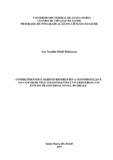| dc.creator | Dallazem, Lia Natália Diehl | |
| dc.date.accessioned | 2019-08-15T12:12:05Z | |
| dc.date.available | 2019-08-15T12:12:05Z | |
| dc.date.issued | 2017-08-24 | |
| dc.identifier.uri | http://repositorio.ufsm.br/handle/1/17928 | |
| dc.description.abstract | The sunlight has essencial biological effects to human life. However, the excessive exposure
causes health damages, like sunburns, photoaging and skin cancer (SC). Under a perspective of
prevention, the sun exposure behaviour has been the central focus, since it is the main risk factor for
skin cancer and it is also changeable. Knowing the profile of photoprotection and risk factors of
populations is fundamental to support SC preventive programs. Young people, such as university
students, may be at increased risk for SC development due to the appreciation of the tan and the
practice of outdoor activities. This cross-sectional study evaluated the photoprotection habits and
knowledge about SC of a university population, composed of undergraduate students from the Federal
University of Santa Maria, RS, Brazil. We selected students from the health area, from professional
areas related to greater photoexposure and from courses not related to these characteristics, totaling
371 students in sample. Recruitment ocurred from October 2016 to February 2017. The level of
knowledge on the subject was satisfactory in less than 90% of students. The data showed that 92% of
the students already had sunburns, and 25.5% stated at least one episode of burns with bubbles.
Adequately used sunscreen was reported by only 34.3% of subjects. Students in the professional risk
areas were associated with a higher number of sunburns of the second degree, greater time of
photoexposure including leisure activities, and only a minority (14.4%) had photoprotection
orientation during the academic life. Those who had this type of orientation in the total sample were
associated with greater adhesion to the use of sunscreen - reinforcing the effectiveness and importance
of photoeducation. These data are consistent with current literature, and will serve as a basis for
targeted and effective SC preventive strategies for this age group. | eng |
| dc.language | por | por |
| dc.publisher | Universidade Federal de Santa Maria | por |
| dc.rights | Attribution-NonCommercial-NoDerivatives 4.0 International | * |
| dc.rights.uri | http://creativecommons.org/licenses/by-nc-nd/4.0/ | * |
| dc.subject | Fotoproteção | por |
| dc.subject | Exposição solar | por |
| dc.subject | Fotoeducação | por |
| dc.subject | Câncer de pele | por |
| dc.subject | Estudantes universitários | por |
| dc.subject | Photoprotection | eng |
| dc.subject | Sun exposure | eng |
| dc.subject | Photoeducation | eng |
| dc.subject | Skin cancer | eng |
| dc.subject | University students | eng |
| dc.title | Conhecimentos e hábitos referentes à fotoproteção e ao câncer de pele em estudantes universitários: um estudo transversal no sul do Brasil | por |
| dc.title.alternative | Knowledge and Habits Concerning Photoprotection and Skin Cancer in University Students: Cross-Sectional Study in Southern Brazil | eng |
| dc.type | Dissertação | por |
| dc.description.resumo | A luz solar tem efeitos biológicos essenciais à vida. A exposição excessiva, porém, apresenta
riscos à saúde, como queimaduras solares, fotoenvelhecimento e câncer de pele (CP). Sob uma
perspectiva de prevenção, o comportamento de exposição solar tornou-se o grande foco, visto que,
além de ser o principal fator de risco para o CP, é também um fator modificável. Conhecer o perfil de
fotoproteção e fatores de risco das populações é fundamental para embasar programas preventivos do
CP. Pessoas jovens, como universitários, podem estar sob risco aumentado para desenvolvimento de
CP devido à valorização do bronzeado e à prática de atividades ao ar livre. Este estudo transversal
avaliou os hábitos de fotoproteção e os conhecimentos sobre CP de uma população universitária,
composta por alunos de graduação da Universidade Federal de Santa Maria, RS, Brasil. Foram
selecionados alunos de cursos da área da saúde, de áreas profissionais relacionadas a maior
fotoexposição e de cursos não relacionados a nenhuma destas características, totalizando 371
indivíduos na amostra. A coleta foi realizada de outubro/2016 a fevereiro/2017. O nível de
conhecimento sobre o assunto foi insatisfatório em quase 15% dos entrevistados. Os dados mostraram
que 92% dos estudantes já apresentaram queimaduras solares e, 25,5% afirmaram pelo menos um
episódio de queimaduras com bolhas. O uso de filtro solar de modo adequado foi referido por apenas
34,3% dos indivíduos. Os alunos das áreas profissionais de risco foram associados a maior número de
queimaduras solares de 2º grau, maior tempo de fotoexposição inclusive nas atividades de lazer, e
apenas uma minoria (14,4%) teve orientação de fotoproteção durante a vida acadêmica. Aqueles que
tiveram este tipo de orientação, na amostra total, foram associados a maior aderência ao uso de filtro
solar – reforçando a eficácia e importância da fotoeducação. Estes dados são concordantes com a
literatura vigente, e servirão de base para estratégias preventivas direcionadas e eficazes para este
grupo etário. | por |
| dc.contributor.advisor1 | Beck, Maristela de Oliveira | |
| dc.contributor.advisor1Lattes | http://lattes.cnpq.br/5466354015919916 | por |
| dc.contributor.referee1 | Pedro, Fabio Lopes | |
| dc.contributor.referee1Lattes | http://lattes.cnpq.br/3151589084035930 | por |
| dc.contributor.referee2 | Menezes, Miriam Seligman de | |
| dc.contributor.referee2Lattes | http://lattes.cnpq.br/8746728488629971 | por |
| dc.creator.Lattes | http://lattes.cnpq.br/3704345914093701 | por |
| dc.publisher.country | Brasil | por |
| dc.publisher.department | Medicina | por |
| dc.publisher.initials | UFSM | por |
| dc.publisher.program | Programa de Pós-Graduação em Ciências da Saúde | por |
| dc.subject.cnpq | CNPQ::CIENCIAS DA SAUDE::MEDICINA | por |
| dc.publisher.unidade | Centro de Ciências da Saúde | por |



